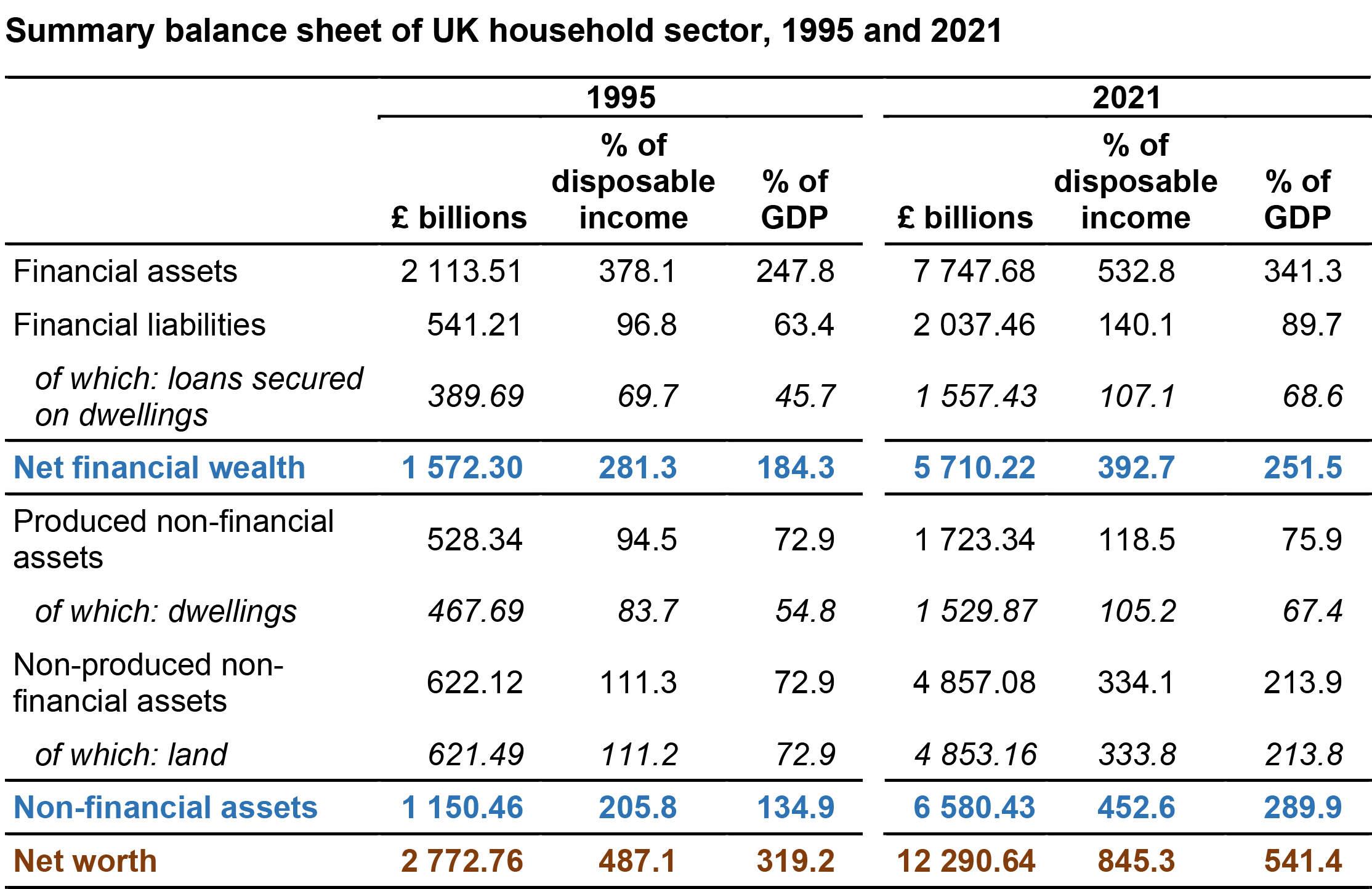 This is the second of three blogs looking at high inflation and its implications. Here we look at changes in the housing market and its effects on households. Another way of analysing the financial importance of the housing and mortgage markets is through the balance sheets and associated flow accounts of the household sector.
This is the second of three blogs looking at high inflation and its implications. Here we look at changes in the housing market and its effects on households. Another way of analysing the financial importance of the housing and mortgage markets is through the balance sheets and associated flow accounts of the household sector.
We used the concept of balance sheets in our blog Bank failures and the importance of balance sheets. In the blog we referred to the balance-sheet effects from interest rate hikes on the financial well-being of financial institutions.
The analysis is analogous for households. Again, we can identify two general effects: rising borrowing and debt-servicing costs, and easing asset prices.
The following table shows the summary balance sheet of the UK household sector in 1995 and 2021.

Source: National balance sheet estimates for the UK: 1995 to 2021 (January 2023) and series RPHA, ONS
The total value of the sector’s net wealth (or ‘worth’) is the sum of its net financial wealth and its non-financial assets. The former is affected by the value of the stock of outstanding mortgages, which we can see from row 3 in the table (‘loans secured on dwellings’) has increased from £390 billion in 1995 to £1.56 trillion in 2021. This is equivalent to an increase from 70 to 107 per cent of the sector’s annual disposable income. This increase helps to understand the sensitivity of the sector’s financial position to interest rate increases and the sizeable cash flow effects. These effects then have implications for the sector’s spending.
 Housing is also an important asset on household balance sheets. The price of housing reflects both the value of dwellings and the land on which they sit, and these are recorded separately on the balance sheets. Their combined balance sheet value increased from £1.09 trillion (£467.69bn + £621.49bn) in 1995 to £6.38 trillion (£1529.87bn + £4853.16bn) in 2021 or from 128% of GDP to 281%.
Housing is also an important asset on household balance sheets. The price of housing reflects both the value of dwellings and the land on which they sit, and these are recorded separately on the balance sheets. Their combined balance sheet value increased from £1.09 trillion (£467.69bn + £621.49bn) in 1995 to £6.38 trillion (£1529.87bn + £4853.16bn) in 2021 or from 128% of GDP to 281%.
The era of low inflation and low interest rates that had characterised the previous two decades or so had helped to boost house price growth and thus the value of non-financial assets on the balance sheets. In turn, this had helped to boost net worth, which increased from £2.78 trillion in 1995 to £12.29 trillion in 2021 or from 319% of GDP to 541%.
Higher interest rates and wealth
 The advent of higher interest rates was expected not only to impact on the debt servicing costs of households but the value of assets, including, in the context of this blog, housing. As Chart 3 in the previous blog helped to show, higher interest rates and higher mortgage repayments contributed to an easing of house price growth as housing demand eased. On the other hand, the impact on mortgaged landlords helped fuel the growth of rental prices as they passed on their increased mortgage repayment costs to tenants.
The advent of higher interest rates was expected not only to impact on the debt servicing costs of households but the value of assets, including, in the context of this blog, housing. As Chart 3 in the previous blog helped to show, higher interest rates and higher mortgage repayments contributed to an easing of house price growth as housing demand eased. On the other hand, the impact on mortgaged landlords helped fuel the growth of rental prices as they passed on their increased mortgage repayment costs to tenants.
Higher interest rates not only affect the value of housing but financial assets such as corporate and government bonds whose prices are inversely related to interest rates. Research published by the Resolution Foundation in July 2023 estimates that these effects are likely to have contributed to a fall in the household wealth from early 2021 to early 2023 by as much as £2.1 trillion.
The important point here is that further downward pressure on asset prices is expected as they adjust to higher interest rates. This and the impact of higher debt servicing costs will therefore continue to impact adversely on general financial well-being with negative implications for the wider macroeconomic environment.
Articles
- The Mortgage Crunch
Resolution Foundation, Simon Pittaway (17/6/23)
- Peaked Interest?
Resolution Foundation, Molly Broome, Ian Mulheirn and Simon Pittaway (17/7/23)
- UK inflation to fall to lowest level since March 2022 but Bank of England still tipped to hike interest rates
City A.M., Jack Barnett (17/7/23)
- Mortgage payments set to jump by £500 for one million households
BBC News, Tom Espiner (13/7/23)
- Interest rates: Big rise less likely after inflation surprise
BBC News, Daniel Thomas, Faisal Islam & Dharshini David (19/7/23)
- Rising Mortgage Costs. What Can Be Done?
NIESR blog, Max Mosley and Adrian Pabst (17/7/23)
- UK interest rates forecast to rise less sharply after inflation falls to 7.9%
The Guardian, Richard Partington (19/7/23)
- Mortgage costs: More Scots falling behind on repayments
Herald Scotland, Kristy Dorsey (18/7/23)
Report
Data
Questions
- What possible indicators could be used to assess the affordability of residential house prices?
- What do you understand by the concept of the monetary policy transmission mechanism? How do the housing and mortgage markets relate to this concept?
- What factors might affect the proportion of people taking out fixed-rate mortgages rather than variable-rate mortgages?
- What is captured by the concept of net worth? Discuss how the housing and mortgage markets affect the household sector’s net worth.
- What are cash-flow effects? How do rising interest rates effect savers and borrowers?
- How might wealth effects from rising interest rates impact younger and older people differently?
- Discuss the ways by which house price changes could affect household consumption.
In a statement to the House of Commons on 9 February 2011, the Chancellor announced that banks would extend their new lending to SMEs (Small and Medium-Sized Enterprises) from £179 billion in 2010 to £190 billion in 2011. An important question is the extent to which this initiative, which forms part of a series of initiatives in conjunction with the banking sector known as Project Merlin, will impact on economic activity.
Let’s begin by thinking about the role that credit plays in an economy. Firstly, it serves a short-term role by enabling individuals and firms to ‘bridge the gap’ between their income and their spending. Secondly, it can, depending on the size and terms of the credit, help to fund longer-term investments. In the case of firms, for instance, it can help to fund capital projects such as an expansion of premises or the installation of new equipment or production processes.
The extension of credit is the main source of growth in the money supply. If the credit which is extended by financial institutions is spent it increases economic activity. The size of the increase in economic activity will depend on how many times the credit is passed on from one firm or individual to the next. In other words, it depends on the velocity of circulation of money – often referred to simply as V. If the initial credit funds a series of purchases and the recipients of these monies, i.e. those from whom the purchases are made, then use their increased deposits to fund purchases themselves, the expansion could be sizeable.
There is every indication that the additional credit for SMEs will be welcome and it seems reasonable to assume that this will positively impact on spending. But, by how much is not entirely clear. This is what fascinates me about macroeconomics, but, perhaps understandably, may well frustrate others! Once the payments for the purchases made using the newly available credit become new deposits, how will these recipients respond? Will other credit-constrained firms use this liquidity to engage in purchases themselves? But, what if these recipients use the monies to increase or rebuild their own financial wealth? In this last scenario – a pessimistic scenario – the velocity of circulation will increase relatively little and economic activity little too.
The corporate sector, of course, does not exist in isolation of other sectors of the economy and, in particular, of the household sector. As some of the income from the expanded credit flows to them in the form of factor payments (i.e. wages and profits) – though by how much is itself debtable – how will they respond? Again will credit-constrained households look to spend? Alternatively, will they hold on to these liquid balances perhaps using them as buffer-stock savings? This is not an unrealistic possibility given the leverage of households and the need to rebuild wealth, especially so in times of incredible economic uncertainty? But, who knows!
So while Merlin may have waved his wand, the full extent of its impact, though probably positive, is far from clear. Time will tell. Isn’t macroeconomics wonderful!
HM Treasury Press Release
Government welcomes banks’ statement on lending by 15% more to SMEs, and on pay and support for regional growth, HM Treasury, 9 February 2011
Statement to the House of Commons by the Chancellor
Statement on banking by the Chancellor of the Exchequer 9 February 2011
Articles
 Banks sign lending and bonus deal BBC News (9/2/11)
Banks sign lending and bonus deal BBC News (9/2/11)
Banks agree Project Merlin lending and bonus deal BBC News (9/2/11)
Osborne’s plans arrive too late for the economy Independent, Sean O’Grady (11/2/11)
Project Merlin ‘could weaken UK banks’ Telegraph, Harry Wilson (11/2/11)
Nothing wizard about Project Merlin Guardian UK, Nils Pratley (7/2/11)
Softball: Britain’s banks make peace with the government – for now The Economist (10/2/11)
Smaller firms insist banks must change their attitude The Herald (11/2/11)
Questions
- Detail the various roles that financial institutions play in a modern-day economy.
- Do the activities of banks carry with them any risks? How might such risks be reduced?
- What is meant by the velocity of circulation or the velocity of money?
- What factors do you think could affect the velocity of money?
- How does credit creation affect the growth of the money supply?
- What do you understand by individuals or firms being credit-constrained?
- What factors are likely to affect how credit-constrained an individual household is?
- What do you think might be meant by buffer-stock saving? What might affect the size of the buffer-stock held by a household?
There is a new craze sweeping across nations. We might call it the Consolidation Conga! Across the world, and, in particular Europe, government after government seems to be announcing plans to cut its budget deficit. But, with so much focus on governments’ plans for fiscal consolidation it would be all too easy to ignore evidence of consolidation in other sectors too. In the UK, the household sector continues to show a zest for the consolidation of its own finances.
Figures from the Bank of England show that during April net unsecured lending, i.e. lending through credit cards, overdrafts and personal loans less repayments, was again in negative territory, this time to the tune of £136 million. This means that the repayment of unsecured debt exceeded new unsecured lending by £136 million. When an allowance is made for unsecured debt ‘written off’ by financial institutions, we find that the stock of unsecured debt fell by £827 million.
April’s fall in the stock of unsecured debt means that the household sector’s stock of unsecured debt has now fallen for 11 months in a row. Over this period the stock of unsecured debt has fallen by £11.47 billion or by 4.9%. Some of this fall is clearly attributable to the ‘writing off’ of bad debts since net unsecured lending has been negative in only 6 of these 11 months. However, this should not detract from our central message of a consolidation by households of their finances. Indeed, the sum of net unsecured lending over these 11 months is -£459 million. In other words, over the period from June 2009 to April 2010 the household sector made a net repayment of unsecured debt of some £459 million.
While the stock of unsecured debt has fallen by £11.47 billion since last June to stand at £220.77 billion in April 2010, the household sector’s overall stock of debt has fallen too, although only by £178 million to £1,459.5 billion. The much smaller decrease in total debt reflects an increase in the stock of mortgage debt by £11.291 billion over the same period. But, there are two points to make here. Firstly, it is difficult to over-play the fact that the overall stock of household debt has fallen. If we look at the Bank of England’s monthly series which goes back to April 1993, the first monthly fall in the total stock of debt did not occur until October 2008. In other words, the norm has simply been for total household debt to increase.
The second point to make is that the growth in secured debt has slowed markedly. The stock of secured debt in April was only 0.9% higher than a year earlier. But, more than this, the Bank of England’s Housing Equity Withdrawal numbers show that since the second quarter of 2008 the household sector’s stock of secured borrowing has increased by less than we would have expected given the additional housing investment, i.e. money spent on moving costs, the purchase of newly built properties or expenditure on major home improvements. This has resulted in what we know as negative Housing Equity Withdrawal (HEW). This again is evidence that households too are consolidating.
The desire for the household sector to consolidate and to reduce its exposure to debt is pretty understandable, especially given these uncertain times. But, as we discuss in Has the tide turned for Keynesianism?, there are dangers for national and global aggregate demand of mass consolidation. It remains to be seen if we can really afford for so many to be dancing the Consolidation Conga!
Articles
Housing market on a knife edge with no sign of sustained recovery in lending Independent, David Prosser (3/6/10)
UK mortgage lending edges higher BBC News (2/6/10)
Mortgage data raise housing recovery fears Financial Times, Norma Cohen (2/6/10)
Mixed lending data point to stagnant housing markets Reuters (2/6/10)
Mortgage approvals slightly higher Press Association (3/6/10)
Data
Lending to individuals Bank of England
Monetary and Financial Statistics (Bankstats) Bank of England (See Tables A5.1 to A5.7, in particular)
Housing equity withdrawal (HEW) statistical releases Bank of England
Questions
- What does a negative net lending figure indicate?
- If net lending is negative does this mean that the stock of debt is falling?
- What factors might be driving households to consolidate their finances?
- Discuss the potential economic benefits and dangers of households consolidating their finances.
- Of what significance is the extent of the household sector’s consolidation of its finances for: (i) the government and (ii) the Bank of England?
 This is the second of three blogs looking at high inflation and its implications. Here we look at changes in the housing market and its effects on households. Another way of analysing the financial importance of the housing and mortgage markets is through the balance sheets and associated flow accounts of the household sector.
This is the second of three blogs looking at high inflation and its implications. Here we look at changes in the housing market and its effects on households. Another way of analysing the financial importance of the housing and mortgage markets is through the balance sheets and associated flow accounts of the household sector. 
 Housing is also an important asset on household balance sheets. The price of housing reflects both the value of dwellings and the land on which they sit, and these are recorded separately on the balance sheets. Their combined balance sheet value increased from £1.09 trillion (£467.69bn + £621.49bn) in 1995 to £6.38 trillion (£1529.87bn + £4853.16bn) in 2021 or from 128% of GDP to 281%.
Housing is also an important asset on household balance sheets. The price of housing reflects both the value of dwellings and the land on which they sit, and these are recorded separately on the balance sheets. Their combined balance sheet value increased from £1.09 trillion (£467.69bn + £621.49bn) in 1995 to £6.38 trillion (£1529.87bn + £4853.16bn) in 2021 or from 128% of GDP to 281%. The advent of higher interest rates was expected not only to impact on the debt servicing costs of households but the value of assets, including, in the context of this blog, housing. As Chart 3 in the previous blog helped to show, higher interest rates and higher mortgage repayments contributed to an easing of house price growth as housing demand eased. On the other hand, the impact on mortgaged landlords helped fuel the growth of rental prices as they passed on their increased mortgage repayment costs to tenants.
The advent of higher interest rates was expected not only to impact on the debt servicing costs of households but the value of assets, including, in the context of this blog, housing. As Chart 3 in the previous blog helped to show, higher interest rates and higher mortgage repayments contributed to an easing of house price growth as housing demand eased. On the other hand, the impact on mortgaged landlords helped fuel the growth of rental prices as they passed on their increased mortgage repayment costs to tenants.